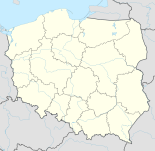Jeziorki Wielkie
| Jeziorki Wielkie | ||
|---|---|---|

|
|
|
| Basic data | ||
| State : | Poland | |
| Voivodeship : | Warmia-Masuria | |
| Powiat : | Gołdap | |
| Gmina : | Gołdap | |
| Geographic location : | 54 ° 13 ' N , 22 ° 13' E | |
| Residents : | 87 (March 31, 2011) | |
| Telephone code : | (+48) 87 | |
| License plate : | NGO | |
| Economy and Transport | ||
| Street : | Voivodeship street ext . 650 : Gołdap ↔ Banie Mazurskie - Węgorzewo | |
| Gieraliszki → Jeziorki Wielkie | ||
| Rail route : | no rail connection | |
| Next international airport : | Danzig | |
Jeziorki Wielkie ( German (large) Jesziorken , 1930 to 1945 Schöntal ) is a village in the Polish Warmian-Masurian Voivodeship , which belongs to the urban and rural municipality Gołdap (Goldap) in the Gołdap district.
Geographical location
Jeziorki Wielkie is located in the northeast of the Warmia-Masurian Voivodeship , north of the Borkener Forest (also: Borker Heide, Polish: Puszcza Borecka). It is 13 kilometers to the northeast to the district town of Gołdap (Goldap) .
history
The village called Schmalmowa at the time was founded in 1564/65. In the following period the place name changed to Jesiorcken (before 1785), Groß Jesziorken (after 1827) and Jesziorken, Kr. Goldap (after 1900).
From 1874 to 1945 the place was incorporated into the district of Altenbude (Polish: Siedlisko), which was part of the Goldap district in the Gumbinnen administrative district of the Prussian province of East Prussia .
In 1827, the residential area Klein Jesziorken (Polish: Jeziorki Małe) was founded just a few hundred meters further northeast, which means that the previous Jesziorken was given the addition of large in its name, which was however repealed at the beginning of the 20th century.
In 1910 Groß Jesziorken had 313 inhabitants. On September 30, 1928, the neighboring village of Herzogsthal (no longer existent) was incorporated into the rural community known as “Jesziorken” (no additional name). The number of inhabitants rose to 389 by 1933 and was already 411 in 1939.
On December 4, 1930, the rural community Jesziorken was renamed “Schöntal”. In 1945, the village came in consequence of the war with the entire southern East Prussia to Poland and received the Polish form of the name "Jeziorki Wielkie". Today the village is the seat of a Schulzenamt (Polish: Sołectwo) and a locality within the urban and rural municipality Gołdap in the powiat Gołdapski , until 1998 the Suwałki Voivodeship , since then the Warmia-Masurian Voivodeship belongs to.
religion
Until 1945 the majority of the Protestant residents (Groß) Jesziorkens belonged to the parish of the Church of Grabowen (1938 to 1945: Arnswald, Polish: Grabowo) in the parish of Goldap in the church province of East Prussia of the Church of the Old Prussian Union . The Catholic church members were parish after Goldap in the diocese of Warmia .
Today the majority of the inhabitants of Jeziorki Wielkies are Catholic . The parish church is still the one in the district town. Today it is part of the Gołdap deanery in the Diocese of Ełk (Lyck) of the Catholic Church in Poland . The few Protestant church members living here now belong to the parish in Gołdap , a subsidiary of the Suwałki parish in the Masurian diocese of the Evangelical Augsburg Church in Poland .
traffic
Jeziorki Wielkie is conveniently located on the Polish voivodeship road DW 650 (former German Reichsstraße 136 ), which connects the two district towns of Węgorzewo (Angerburg) and Gołdap. In town ends a side road coming from Gieraliszki (Gerehlischken , 1938 to 1945 Gerwalde) .
Until 1945 there was a connection to the Angerburg – Goldap railway line via the station in Grabowen (1938 to 1945: Arnswald, Polish: Grabowo) , which was not put back into operation after the war.
Individual evidence
- ^ CIS 2011: Ludność w miejscowościach statystycznych według ekonomicznych grup wieku , March 31, 2011, accessed on April 21, 2019 (Polish).
- ↑ a b Dietrich Lange: Geographical Register of Places East Prussia: Schöntal (2005)
- ^ Rolf Jehke: District Altenbude
- ↑. Uli Schubert: community directory, district Goldap
- ^ Michael Rademacher: German administrative history from the unification of the empire in 1871 to the reunification in 1990. Goldap district. (Online material for the dissertation, Osnabrück 2006).
- ↑ Walther Hubatsch : History of the Protestant Church in East Prussia. Volume 3: Documents. Göttingen 1968, p. 479

